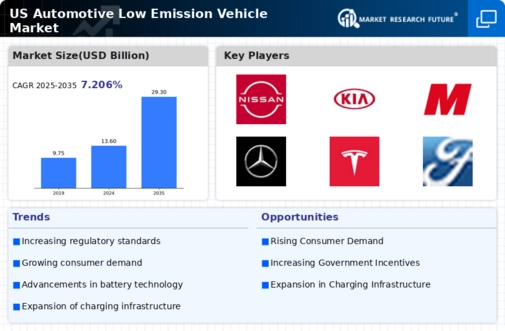Regulatory Framework Enhancements
The automotive low-emission-vehicle market is experiencing a robust influence from evolving regulatory frameworks. In the US, federal and state governments are implementing stricter emissions standards, which compel manufacturers to innovate and produce vehicles that meet these requirements. For instance, the Environmental Protection Agency (EPA) has set ambitious targets for reducing greenhouse gas emissions from light-duty vehicles, aiming for a reduction of 50% by 2030. This regulatory push not only drives manufacturers to invest in low-emission technologies but also creates a competitive landscape where compliance becomes a key differentiator. As a result, the automotive low-emission-vehicle market is likely to see increased production and sales of compliant vehicles, fostering a shift towards cleaner transportation options.
Corporate Sustainability Initiatives
Many corporations in the US are adopting sustainability initiatives that significantly impact the automotive low-emission-vehicle market. Companies are increasingly committing to reducing their carbon footprints, which often includes transitioning their fleets to low-emission vehicles. A recent survey indicated that approximately 60% of large corporations plan to invest in electric or hybrid vehicles by 2026. This trend not only reflects a growing awareness of environmental issues but also aligns with consumer preferences for sustainable practices. As businesses lead by example, the automotive low-emission-vehicle market is likely to benefit from increased demand driven by corporate responsibility and sustainability goals.
Consumer Awareness and Education Campaigns
Consumer awareness plays a pivotal role in shaping the automotive low-emission-vehicle market. Educational campaigns aimed at informing the public about the benefits of low-emission vehicles are gaining traction. These initiatives often highlight the long-term cost savings associated with electric vehicles, such as lower fuel and maintenance costs. As of 2025, studies suggest that consumers are increasingly recognizing the financial and environmental advantages of low-emission vehicles, with nearly 70% expressing interest in purchasing one. This heightened awareness is likely to drive demand, as informed consumers make more sustainable choices, thus positively impacting the automotive low-emission-vehicle market.
Technological Innovations in Vehicle Design
Innovations in vehicle design are reshaping the automotive low-emission-vehicle market. Advances in aerodynamics, lightweight materials, and energy-efficient systems are enhancing the performance and efficiency of low-emission vehicles. For instance, the integration of advanced materials can reduce vehicle weight by up to 20%, leading to improved fuel efficiency and lower emissions. Additionally, manufacturers are exploring alternative powertrains, such as hydrogen fuel cells, which could further diversify the market. As these technological advancements continue to evolve, they are expected to attract a broader consumer base, thereby propelling the automotive low-emission-vehicle market forward.
Infrastructure Development for Charging Stations
The expansion of charging infrastructure is a critical driver for the automotive low-emission-vehicle market. The US government, alongside private sector investments, is actively working to increase the number of charging stations across urban and rural areas. As of 2025, there are over 100,000 public charging stations available, with plans to double this number by 2030. This development alleviates range anxiety among consumers, making low-emission vehicles more appealing. Furthermore, the availability of fast-charging options enhances the convenience of owning an electric vehicle, thereby stimulating demand. Consequently, the automotive low-emission-vehicle market is poised for growth as infrastructure improvements support wider adoption.
























Leave a Comment